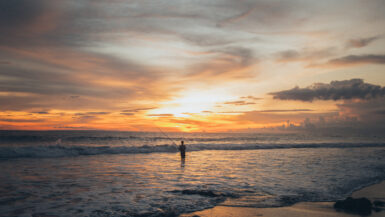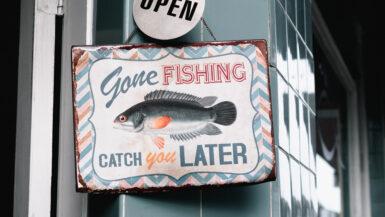Fishing for Bass in ponds and small lakes can be an enjoyable and rewarding activity for both experienced and beginning anglers. With the proper information and techniques, anyone can have success catching Bass regardless of your skill level. In this article, we will cover the basics of Bass fishing in ponds and small lakes, including the ideal tackle, the right lures and bait, and the necessary techniques. Armed with this information, you can be out enjoying a day of Bass fishing in no time.
Gathering the Necessary Equipment
Fishing for bass in ponds and small lakes can be a great way to enjoy the outdoors and get some fresh air while also having the potential to bring in a large catch. When you are preparing to fish for bass, there are a few key pieces of equipment that you will want to gather to ensure you have a successful trip.
Choosing the Right Fishing Rod and Reel
When beginning your fishing expedition, one of the first things you will need to consider is the type of rod and reel you want to use. The type of rod you will want to use will depend greatly on the size of bass you are looking to catch and the size of the body of water you will be fishing in. For example, if you are fishing for larger bass in a larger pond or lake, you may want to opt for a slightly heavier rod and reel.
Picking the Right Lures and Baits
No matter where you are fishing, you will need to have the right lures and bait. Lures come in a variety of shapes, sizes, and colors, and can be used to attract bass. Depending on the type of bass you are fishing for, you will want to select the right lure to ensure you have a successful outing. Additionally, you may want to bring along a few different types of bait, as different baits will attract different types of bass.
Gathering Essential Accessories
In addition to the rod, reel, and bait, there are a few essential accessories you should bring along with you on your fishing trip. Necessary items may include a net, bucket, line, and tackle box. These items will help to ensure that you have an enjoyable and successful trip.
Considering Protective Gear
As with any outdoor activity, it is important to make sure you are protected from the elements. Items to consider when fishing for bass may include polarized sunglasses, a hat, and sunscreen to protect you from the sun. Additionally, bringing along bug spray and a jacket can help keep away pesky bugs and keep you warm.
Conclusion
Fishing for bass in ponds and small lakes can be a great way to enjoy the outdoors, but it is important to make sure you have the right equipment to ensure a successful outing. When you gather the appropriate rod and reel, lures and baits, and essential accessories, you can be sure that you are prepared and ready to fish. Additionally, considering protective gear items such as sunglasses, a hat, and sunscreen will help ensure that you have an enjoyable and safe experience.
Understanding the Lure Options
Catching bass in ponds and small lakes requires anglers to understand the various types of lures and how they can be used effectively. There is no single best lure for bass, rather a number of different options may be needed to catch fish in different conditions. It is important to select the right lure based on the depth of the lake, type of cover, and the size of the bass you are expecting to catch.
Types of Bass Lures
When it comes to fishing in ponds and small lakes, there are several different types of lures to choose from. These include hard baits, soft baits, jigs and spinnerbaits. Each of these lures has its own advantages and disadvantages, as well as a particular application for catching bass in different conditions.
Hard Baits for Bass Fishing
Hard baits are often used when fishing for bass in depths of up to 15 feet. Examples of hard baits for bass include crankbaits, jerkbaits and topwater lures. These baits are effective for covering large areas of a lake quickly, and can be effective for catching larger bass.
Soft Baits for Bass Fishing
Soft baits, such as grubs, worms, and tubes, are often used when fishing in depths up to 15 feet. They are often used when fishing in shallow, cover-filled areas of a lake, as they can be slowly retrieved to entice bass to take a bite. Soft baits also often produce larger bass than hard baits.
Jigs and Spinnerbaits for Bass Fishing
Jigs and spinnerbaits are often used when fishing in depths of up to 20 feet or so. Jigs are effective for catching bass in deep, cover-filled areas of a lake, while spinnerbaits are effective for covering large areas. Both lures can be effective for catching larger bass, but it is important to select the right size and color for the conditions.
Understanding Lure Colors and Sizes for Bass Fishing
When it comes to selecting the right lure for bass fishing in ponds and small lakes, it is important to understand the types of lures and their applications. It is also important to understand the color and size of the lure, as this can make a big difference in the success of your fishing trip. Light colored lures are often used in murky water, while dark colored lures are often used in clear water. When it comes to size, you should select a lure that is large enough to cover the depth you are fishing, but small enough to entice the bass to take a bite.
Choosing Fishing Line for Bass Fishing
When fishing for bass in ponds and small lakes, it is important to select the right fishing line for the situation. The weight and strength of the line should be chosen based on the size of the bass, depth of the water, and type of lure being used. Monofilament lines are often used when fishing in shallow, clear water, while heavier braided lines and fluorocarbon lines are often used when fishing in deeper, murky water.
Tips for Fishing for Bass in Ponds and Small Lakes
When fishing for bass in ponds and small lakes, it is important to move around the lake and look for the bass. When possible, try to fish the areas with structure, such as fallen trees, stumps, and weed beds. It is also important to keep your lure in the water as much as possible in order to increase the chances of a bass taking the bait. Finally, keep in mind that bass often feed more aggressively in the early morning and late afternoon, so it can be beneficial to plan your fishing trips accordingly.
Identifying the Right Location
When fishing for bass in ponds and small lakes, the first step is choosing the right location. Look for bodies of water that are rich in vegetation and aquatic life. Weed beds, lily pads, and other aquatic vegetation provide cover for bass, allowing them to hide from predators and ambush unsuspecting prey. Additionally, an abundance of small fish, amphibians, crustaceans, and other organisms provide a plentiful food source for bass.
Natural Features
When deciding on a body of water, look for natural features like submerged logs, rocky outcroppings, and points of land that protrude into the water. These structures provide shelter and ambush points for bass, and can make for great fishing spots.
Depth
The depth of the water is also a key factor when determining the best location for bass fishing. In most pond and small lake environments, the water is usually quite shallow and relatively uniform in terms of depth. Opt for the deepest areas of the lake, as bass tend to congregate in these areas.
Seasonal Changes
It is important to keep in mind that water levels and other environmental factors can change from season to season. During the winter months, for example, bass tend to move to deeper areas of the lake in order to conserve energy and avoid the cold temperatures. In the summer, they tend to move to shallower areas in search of food. Be sure to take these seasonal changes into consideration when selecting a spot to fish.
Fishing Equipment Preparation
Once you have identified the right location, it is time to prepare your fishing equipment. The type of bait and lures that you choose will depend on the type of bass you are targeting, the time of year, and other factors. Be sure to do your research and select the appropriate equipment for the conditions you will be fishing in.
Casting and Retrieving Techniques
Selecting the right lure when fishing for bass in ponds and small lakes is essential. Soft-plastic worms, spinnerbaits, crankbaits and swimbaits can all be effective when used in the right situation. To determine the right lure for the conditions, consider the type of habitat, water depth, weather and forage in the water. Knowing the behavior of the bass in the pond or small lake can also help in selecting the appropriate lure.
Applying the Right Presentation
Presentation is the key to any successful fishing trip, and when it comes to pond and small lake bass fishing, applying the right presentation can make all the difference. Bass that stay close to the shoreline in shallow water can be caught with slow and subtle presentations with finesse lures. For bass that live in deeper water, faster retrieves with lures that have more vibrations are usually more successful.
Varying the Technique
Bass in ponds and small lakes can be caught in a variety of ways. Try varying the technique by switching up casting angles, retrieving speed and depth, and lure selection. Also, be aware of the changing conditions in the pond or small lake, such as the amount of sunlight, wind, and temperature, and adjust the technique to match.
Understanding Where Bass Hold
It is important to understand the structure and habitat in ponds and small lakes, as the bass will be drawn to certain areas depending on the conditions. Bass will usually hold in areas with structure such as weed beds, lily pads, rock piles, and drop-offs. These areas provide shelter and food sources and act as natural magnets for the bass. Knowing where the bass are likely to be found can give the angler an advantage and increase their chances of success.
Utilize the Elements
Make the most of the elements when fishing in ponds and small lakes. Wind can create ripples on the surface of the water that attract baitfish and in turn, draw in bass. Clouds will also reduce the glare from the sun and make it easier for the bass to come into shallow water and feed. Utilizing the wind and clouds can give the angler an edge for catching bass.
Identifying the Best Time to Fish for Bass
Fishing for bass in ponds and small lakes is a popular activity for recreational anglers. Knowing when to fish for bass is key for success. The best time to fish for bass depends on a variety of factors relating to the behavior of bass.
Seasonal Factors
The seasonal temperature changes affect the bass, and in turn, affect the activity levels. In cooler months, bass will be found close to deeper areas of the water, as this is where the temperature is more consistent. As the season warms up, the bass will move towards the shallower areas, as this is where they can find food.
Determining Time of Day to Fish
Bass are crepuscular animals, meaning they are most active at dawn and dusk. During the day, they tend to be less active, and can be found searching for food in the shallower parts of the water. At night, they become even less active, and are more likely to be found in deeper, cooler parts of the water.
Factoring in Weather Condition
Weather, such as cloud cover, wind, and atmospheric pressure, can also affect when bass are active. During times of cloudy weather, bass are more likely to be more active, as the cover from the clouds make them feel more secure. Windy days can also increase bass activity as they use the wind to help them locate food.
Using Live Bait During Fishing Expedition
Using live bait is an effective way to attract bass, regardless of time and weather conditions. Live bait such as worms, crickets, and grasshoppers, entices bass far more than lures, and will increase the chances of catching a bass. However, it is important to note that bass are very sensitive to the smell and taste of their food, so live bait should be fresh, and free from any contaminants.
Tips for Fishing for Bass Early in the Morning
For fishermen looking to catch bass early in the morning, the best approach is to target deeper, cooler water. Early mornings are often quite still, so it is important to cast the line out as far as possible, to maximize the reach. Bass are attracted to lures and baits that move, so fluctuating the speed of the line can help to attract the bass.
Tips for Fishing for Bass Late in the Day
Fishing late in the evening is a great opportunity to catch bass, as this is when they become more active. The best approach is to target shallower water, as this is where the bass will be searching for food. It is important to keep the bait moving, as this will help to attract the bass.
By understanding the behavior of bass, anglers can identify the best time of day to go fishing for bass in ponds and small lakes. By following these tips, anglers can increase their chances of having a successful fishing trip.
Fishing for Bass: A Fun and Rewarding Experience
Fishing for bass in ponds and small lakes can be a rewarding and satisfying experience. Bass tend to like the warmer waters found in ponds and small lakes, making them a great target for anglers. To find bass, look for areas with cover, such as lily pads, submerged logs, and rocky shores. Live bait, such as minnows and worms, can be effective for catching bass. Artificial lures, such as jigs and crankbaits, can also be used to land fish. When it comes to selecting the best tackle, light spinning gear or a medium-action rod with 10-15 pound test line is recommended. With the right equipment and some patience, bass fishing can be a fun and rewarding experience.





Leave a reply